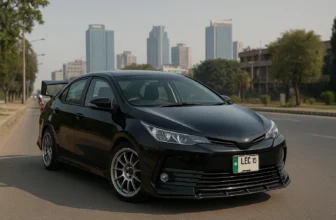
The automotive landscape in Pakistan is witnessing a significant transformation with the introduction of the country’s first electric G-Wagon. This iconic luxury SUV, known for its robust performance and distinctive design, has now embraced electric propulsion, marking a pivotal moment in Pakistan’s journey towards sustainable transportation. This article delves into the features, performance, and implications of the electric G-Wagon in the Pakistani context.
Introduction to the Electric G-Wagon
The Mercedes-Benz G-Class, colloquially known as the G-Wagon, has been a symbol of luxury and off-road prowess since its inception. The transition to an electric variant signifies Mercedes-Benz’s commitment to innovation and environmental responsibility.
Historical Context
Originally designed as a military vehicle in the late 1970s, the G-Wagon evolved into a luxury SUV without compromising its rugged capabilities. The electric version retains the classic boxy aesthetics while integrating cutting-edge electric vehicle (EV) technology.
Global Shift Towards Electric Vehicles
The global automotive industry is rapidly shifting towards electrification, driven by environmental concerns and technological advancements. The electric G-Wagon exemplifies this trend, offering consumers a blend of luxury and sustainability.
Design and Aesthetics
The electric G-Wagon maintains the iconic design elements that enthusiasts cherish, with subtle modifications to reflect its electric nature.
Exterior Design
- Classic Silhouette: The SUV retains its signature boxy shape, flat surfaces, and prominent wheel arches.
- Modern Accents: Features like LED lighting, aerodynamic enhancements, and unique badging distinguish it from its internal combustion engine (ICE) counterparts.
Interior Design
- Luxurious Appointments: Premium materials, advanced infotainment systems, and customizable ambient lighting create an opulent cabin experience.
- Technological Integration: A digital instrument cluster provides real-time data on battery status, range, and performance metrics.
Performance and Specifications
The electric G-Wagon offers impressive performance metrics, ensuring it meets the expectations of both enthusiasts and eco-conscious consumers.
Powertrain and Battery
- Quad-Motor Setup: Four individually controlled electric motors deliver precise power distribution, enhancing both on-road and off-road capabilities.
- Battery Capacity: Equipped with a 116 kWh high-voltage lithium-ion battery, the SUV offers a substantial driving range suitable for various terrains.
Performance Metrics
- Power Output: The combined output of the electric motors provides robust acceleration and torque.
- Acceleration: Capable of achieving 0 to 100 km/h in approximately 4.6 seconds, rivaling traditional performance SUVs.
Charging Capabilities
- Fast Charging: Supports up to 250 kW fast charging, enabling rapid replenishment of battery levels.
- Charging Infrastructure: Compatibility with standard charging stations facilitates convenient charging options for users.
Off-Road Capabilities
True to its heritage, the electric G-Wagon excels in off-road scenarios, thanks to its advanced engineering.
Terrain Management
- Individual Wheel Control: The quad-motor system allows for precise torque distribution to each wheel, enhancing traction on uneven surfaces.
- Adaptive Suspension: Adjustable suspension settings enable the vehicle to tackle various terrains with ease.
Durability Features
- Robust Construction: The battery is housed within a torsion-resistant casing, protecting it from environmental hazards.
- Underbody Protection: Reinforced underbody shields safeguard critical components during off-road excursions.
Implications for Pakistan
The introduction of the electric G-Wagon in Pakistan holds significant implications for the automotive market and environmental sustainability.
Market Dynamics
- Luxury EV Segment: The electric G-Wagon caters to a niche market, appealing to affluent consumers seeking eco-friendly alternatives without compromising on luxury.
- Consumer Perception: Its presence may influence public perception, encouraging broader acceptance of electric vehicles in the country.
Environmental Impact
- Emission Reduction: Adoption of electric vehicles contributes to decreased greenhouse gas emissions, aligning with global environmental goals.
- Sustainable Practices: Encourages the development of infrastructure and policies supporting sustainable transportation solutions.
Challenges and Considerations
While the electric G-Wagon offers numerous benefits, certain challenges must be addressed to ensure its success in Pakistan.
Infrastructure Development
- Charging Stations: The availability of fast-charging stations is crucial for the practicality of electric vehicles, especially in urban centers.
- Grid Capacity: Ensuring the electrical grid can handle increased demand is essential for widespread EV adoption.
Cost Factors
- Import Duties: High taxes and duties on imported vehicles can significantly affect the final retail price.
- Maintenance Costs: While EVs generally have lower maintenance requirements, specialized parts and services may incur higher expenses.
Comparison with Traditional G-Wagon
Understanding the distinctions between the electric and traditional G-Wagon models provides insight into the evolution of this iconic vehicle.
| Feature | Electric G-Wagon | Traditional G-Wagon |
|---|---|---|
| Powertrain | Four electric motors | Internal combustion engine |
| Acceleration (0-100 km/h) | ~4.6 seconds | Varies by model, generally higher |
| Emissions | Zero tailpipe emissions | CO₂ and other pollutants |
| Fuel Source | Electricity | Petrol/Diesel |
| Maintenance | Fewer moving parts, potentially lower costs | Regular engine and transmission upkeep |
Future Outlook
The electric G-Wagon’s debut in Pakistan may pave the way for broader EV adoption and influence future automotive trends.
Policy Implications
- Incentives: Government policies offering tax breaks or subsidies could make EVs more accessible to consumers.
- Regulations: Establishing standards for charging infrastructure and vehicle safety ensures a cohesive transition to electric mobility.
Consumer Trends
- Growing Interest: As awareness increases, more consumers may consider EVs for their next vehicle purchase.
- Brand Expansion: Success of the electric G-Wagon could encourage other luxury brands to introduce their electric models in the Pakistani market.
Conclusion
The arrival of Pakistan’s first electric G-Wagon signifies a milestone in the nation’s automotive history, blending luxury with sustainability. While challenges exist, the potential benefits to consumers and the environment are substantial. Embracing this innovation could accelerate the country’s shift towards a more sustainable and technologically advanced transportation ecosystem.






